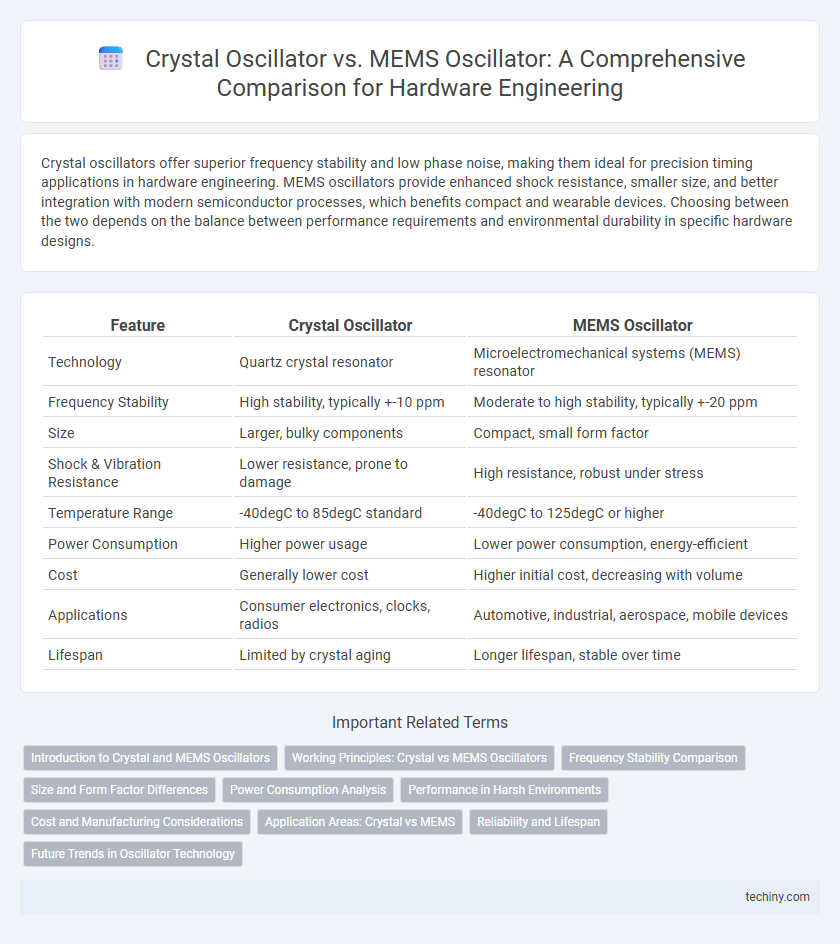Crystal oscillators offer superior frequency stability and low phase noise, making them ideal for precision timing applications in hardware engineering. MEMS oscillators provide enhanced shock resistance, smaller size, and better integration with modern semiconductor processes, which benefits compact and wearable devices. Choosing between the two depends on the balance between performance requirements and environmental durability in specific hardware designs.
Table of Comparison
| Feature | Crystal Oscillator | MEMS Oscillator |
|---|---|---|
| Technology | Quartz crystal resonator | Microelectromechanical systems (MEMS) resonator |
| Frequency Stability | High stability, typically +-10 ppm | Moderate to high stability, typically +-20 ppm |
| Size | Larger, bulky components | Compact, small form factor |
| Shock & Vibration Resistance | Lower resistance, prone to damage | High resistance, robust under stress |
| Temperature Range | -40degC to 85degC standard | -40degC to 125degC or higher |
| Power Consumption | Higher power usage | Lower power consumption, energy-efficient |
| Cost | Generally lower cost | Higher initial cost, decreasing with volume |
| Applications | Consumer electronics, clocks, radios | Automotive, industrial, aerospace, mobile devices |
| Lifespan | Limited by crystal aging | Longer lifespan, stable over time |
Introduction to Crystal and MEMS Oscillators
Crystal oscillators utilize quartz crystals to generate stable and precise frequency signals through the piezoelectric effect, making them essential in applications requiring high stability and low phase noise. MEMS oscillators leverage microelectromechanical systems technology to produce clock signals with enhanced resilience to shock, vibration, and temperature variations, offering increased integration flexibility and reduced size. Both oscillator types serve critical roles in timing solutions, with crystal oscillators typically used in traditional communication and computing systems, while MEMS oscillators are gaining traction in mobile devices and IoT applications due to their robustness and scalability.
Working Principles: Crystal vs MEMS Oscillators
Crystal oscillators rely on the piezoelectric effect of quartz crystals, where mechanical vibrations generate a precise frequency signal through resonant oscillations. MEMS oscillators use microelectromechanical systems technology, employing tiny silicon-based resonators that vibrate to produce stable frequency signals with enhanced shock and temperature resistance. The inherent mechanical resonance of quartz defines traditional crystal oscillators, while MEMS oscillators leverage semiconductor microfabrication for compact, robust frequency control.
Frequency Stability Comparison
Crystal oscillators exhibit superior long-term frequency stability due to their quartz resonators' low aging rates and minimal frequency drift over temperature variations. MEMS oscillators offer enhanced robustness against shock and vibration but typically show greater frequency instability, especially in extreme environmental conditions. Precision hardware designs prioritize crystal oscillators for applications demanding stringent frequency accuracy and stability.
Size and Form Factor Differences
Crystal oscillators traditionally utilize quartz crystals, leading to relatively larger sizes and rigid form factors constrained by the cut and packaging of the quartz element. MEMS oscillators leverage microelectromechanical systems technology, enabling significantly smaller footprints and more flexible, compact form factors suitable for space-constrained hardware designs. The miniaturization of MEMS oscillators contributes to their integration in modern portable electronics, where reduced size and adaptability are critical design priorities.
Power Consumption Analysis
Crystal oscillators typically exhibit lower power consumption due to their passive resonator structure which relies on quartz crystal vibration, consuming minimal energy during operation. MEMS oscillators, while offering advantages in size and robustness, generally consume more power because of their integrated active circuitry required to maintain stable oscillation frequencies. Power efficiency in crystal oscillators makes them preferable in battery-powered and low-power hardware engineering applications demanding long operational life.
Performance in Harsh Environments
Crystal oscillators exhibit superior frequency stability and low phase noise, making them reliable under temperature extremes and mechanical stress in harsh environments. MEMS oscillators offer enhanced shock and vibration resistance due to their microelectromechanical structure, with faster startup times and better tolerance to humidity and contaminants. Performance trade-offs depend on specific harsh conditions, where crystal oscillators excel in signal purity, while MEMS oscillators provide robustness in rugged or space-constrained hardware applications.
Cost and Manufacturing Considerations
Crystal oscillators typically have lower unit costs due to mature manufacturing processes and widespread availability of quartz crystals, making them economical for high-volume production. MEMS oscillators offer advantages in cost-effectiveness at scale by leveraging semiconductor fabrication techniques, reducing assembly complexity and enabling integration with other IC components. Manufacturing considerations include the fragile nature of quartz crystals requiring careful handling, whereas MEMS devices benefit from robust silicon-based substrates and better resistance to environmental stress.
Application Areas: Crystal vs MEMS
Crystal oscillators dominate applications requiring high frequency stability and low phase noise, such as telecommunications, GPS modules, and precision measurement equipment. MEMS oscillators excel in environments demanding mechanical robustness, low power consumption, and miniaturization, making them ideal for mobile devices, IoT sensors, and automotive electronics. Both technologies serve critical roles, with crystal oscillators preferred for high-performance timing and MEMS oscillators favored in compact, vibration-prone applications.
Reliability and Lifespan
Crystal oscillators offer high frequency stability and long-term reliability with typical lifespans exceeding 20 years due to their quartz crystal resonators' inherent precision. MEMS oscillators, leveraging microelectromechanical systems technology, provide enhanced mechanical shock resistance and better performance in harsh environments but generally have shorter lifespans, often ranging from 10 to 15 years. The choice between crystal and MEMS oscillators depends on application-specific reliability requirements and environmental conditions influencing oscillator durability.
Future Trends in Oscillator Technology
Future trends in oscillator technology emphasize the integration of MEMS oscillators due to their robustness, miniaturization, and low power consumption compared to traditional crystal oscillators. Advancements in MEMS fabrication techniques enable higher frequency stability and reduced phase noise, positioning MEMS oscillators as the preferred choice for next-generation IoT, 5G, and aerospace applications. Continued innovation in temperature-compensated MEMS designs aims to surpass crystal oscillators in precision and reliability, driving industry-wide adoption.
Crystal Oscillator vs MEMS Oscillator Infographic

 techiny.com
techiny.com